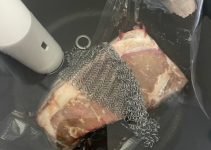Table of Contents
I want all Sous Vide beginners to have a great first impression of our favorite method of cooking. It took me a while to learn some of these mistakes, and I am happy to share my wisdom with you including some common Sous Vide mistakes.
Sous vide allows you to make restaurant-quality dishes every single time. It’s also super convenient. Simply seal your steak or fish, toss it into the freezer, and when you’re hungry, put it in your sous vide bath.
Although this might sound simple, there are a few common mistakes that beginners make that negatively impact the flavor and texture of their food.
So in this post, I’ll go over five mistakes that every beginner makes when preparing food with sous vide and how to avoid them. I’ll also share a few additional tips that help bring out more flavor in your food.
1. Not Submerging Your Bag Properly
Many beginners struggle with properly submerging their sous vide bag. You season your meat, put it into a bag and submerge it into the bath, but it keeps rising to the top. This is frustrating; however, there are a few simple fixes.
The main problem is air.
Your sous vide bag still contains air, and since air is lighter than water, when you place your bag into the bath, it floats.
The easiest way to fix this problem is to get a vacuum sealer. You could get a high-quality sealer at your local store for around $50 to $100.
However, avoid cheap sealers. These lower-end sealers can only seal a small surface area at a time, and some don’t even do a good job. So consider investing in a quality sealer.
But if you don’t want to buy a vacuum sealer, try the water displacement method. It might not work as well as a sealer, but it gets rid of almost all air, so your bag doesn’t float.
First, put your meat in a ziplock sous vide bag, and close it almost all the way. There should be around an inch open. Next, get a tub of water and gently lower your bag into it. And as the food goes down, the water pressure pushes all the air out of the bag.
Go down until that little corner of the bag is almost underwater, and seal it off.
This is guaranteed to prevent your pouch from floating the next time you prepare a meal.
2. Forgetting That Eggs Are Delicate
I love using sous vide cooking to prepare eggs. It’s convenient, and you can cook eggs to the exact doneness you want. This makes it a better option than boiling since you’ll need to remove the eggs at the perfect moment.
However, many people like adding some eggs into their sous vide bath without vacuum sealing it. And although there’s nothing wrong with that, it increases your risk of cracking your eggs.
This results in egg spilling out into your water which is unpleasant. The broken shells can even get in your sous vide machine, damaging it.
Instead, vacuum seal your eggs and carefully place them into your warm bath. Make sure your eggs don’t bang against your pot or bowl.
Although you can still crack your eggs with this technique, eggshells won’t go into your sous vide machine.
3. Not Using The Right Amount of Water
Many beginners add either too much or too little water, and this can be frustrating.
Maybe you’ll fill the sous vide pot just below the maximum line, and when you put your bag in it, water overflows. Or even worse, you add some water, put your bag in the bath and head off to work or school, hoping for a nice dinner when you come home. However, the water is gone a few hours later, and your meat isn’t even cooked yet.
When I first started using sous vide to prepare meals, this happened to me, which ruined my entire day.
However, there’s an easy way to add just the perfect amount of water.
First, fill up your sous vide pot until it meets the minimum line. Next, place your bag inside and you’ll see the line raise slightly. Last, fill up your pot until it reaches the top line.
This way, you won’t spill water when you put your bag inside, and all the water won’t evaporate because you added the maximum amount.
4. Overcooking Your Meats
Most people think you can’t overcook food with sous vide. And to an extent, this is true. You won’t burn your steak like you would when frying or grilling it in a pan. However, you can overdo it, leading to a darker steak.
The first and most common reason why your meats are overcooked is that they’re too thin.
The thinner a slice of meat is, the quicker it takes for heat to travel to the center. To avoid this, read the owner’s manual for your sous vide machine and check for recommended temperatures.
The second reason is you’re searing your meat for too long.
Everyone loves that crust that forms around a steak after it’s seared. However, be careful when searing your meat because heat can reach the center and affect its overall doneness.
So keep your pan on high heat and sear it quickly, especially if it’s a thin piece of meat. A good rule of thumb is to sear a thicker piece of steak on high heat for one minute, while thinner cuts can be done in 30 seconds.
But if you want a foolproof way of searing steaks without affecting the inside, use a blow torch.
You can get a quality blow torch for around $30 to $50. When searing your steak, keep the torch around two to three inches away from the surface and continue searing until you have your desired crust. This method won’t cook the inside of your steak as much compared to a pan sear.
5. Incorrect Use of a Pouch
Another common mistake that many people make is not closing the sous vide pouch properly. This causes water to leak into your bag and can ruin your meal. Instead, close your bags using the water displacement method or a vacuum sealer.
Also, invest in high-quality bags because cheaper alternatives tend to leak over time.
When handling your sous vide pouches, don’t use tongs. If you’re cooking delicate foods like fish fillets, then tongs can damage your meal. Instead, let the top part of the bag rest above water so you can remove it with a cloth.
But it’s not only tongs that can puncture your bag. Certain foods with sharp stems like asparagus can also damage your bag.
6. Not Drying Food Well Before Searing
Something I learned from a good friend chef of mine, is how important it is to make sure your food is completely dry before searing.
If there is moisture on the food or meat during the sear, it will instantly steam in the pan and make it much more difficult to get that crust we all know and love.
As soon as you are ready to sear your food, pat it dry very well with towels or paper towels. Then you are ready to sear that baby!
Some Additional Tips to Help You Avoid Mistakes
Here are some tips that’ll help you avoid some common sous vide mistakes:
• Don’t add too much strong seasoning
• Pre-sear your meat
• Prioritize safety
Don’t Add Too Much Strong Seasoning
When cooking meats in a sous vide bath, you want to carefully pick which spices and herbs you add. Some spices are quite strong and can overpower the taste of your food. It can even turn rancid if you leave it in the bag for too long.
So when starting out, salt and pepper should do. If you want some more flavor, you can add lemon, garlic, and butter, but don’t add too much too soon.
Pre-Sear Your Meat
Many chefs don’t promote the idea of searing your meat before putting it in the bag.
However, I’m a big fan of pre-searing meat since it adds a noticeable amount of flavor to your meal and the fat isn’t so rubbery.
The reason fat tastes rubbery after sous vide is because of temperature. Fat renders at high temperatures, and since sous vide doesn’t use high temperature, fat goes unrendered. By pre-searing your meat, you kickstart the rendering process, releasing massive amounts of flavor.
Prioritize Safety
You shouldn’t leave meat unrefrigerated for more than two hours. Also, the maximum amount of time you can leave food in a vacuum-sealed bag is three days. After this, it starts to develop botulism, a type of food poisoning leading to nausea, diarrhea, and vomiting.
Conclusion
Sous vide cooking allows you to make restaurant-quality food consistently. It’s also super convenient because you can just put some meat into the warm bath and return in a few hours.
However, there are a few common mistakes that beginners make that negatively impact the taste and texture of their food. Fortunately, by avoiding these mistakes, you’ll be well on your way to cooking up perfect meals.
Don’t forget to check our our favorite Sous Vide Cookbooks and Machines!







Can you cook large quantities of marinating kabob pieces in large ziplocks? Will it cook evenly?
Hi Kathy! Should be okay just make sure they are in one layer
Yes just make sure they are flat in the bag